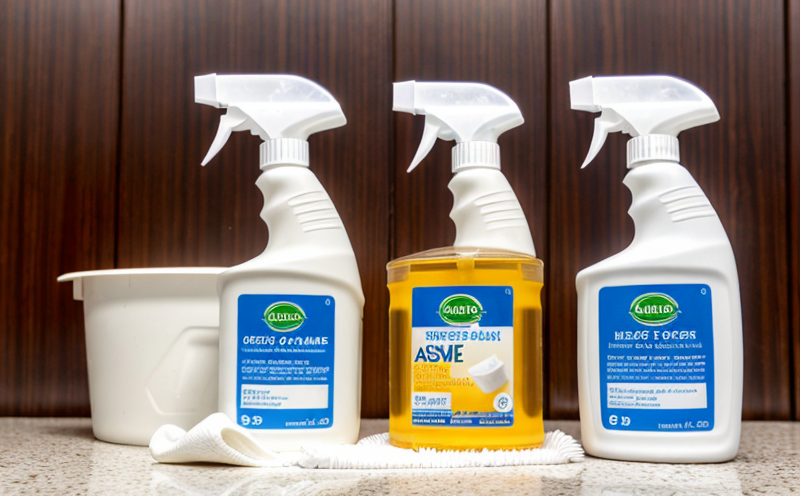EPA 872 Virucidal Testing of Disinfectants
The EPA guideline Method 872.1: Determination of the Viricidal Activity of Antimicrobial Pesticides Against Enveloped Viruses by Plaque Reduction Assay, commonly referred to as EPA Method 872, is a pivotal standard for evaluating the efficacy of disinfectants designed to kill enveloped viruses. This testing ensures that products meet stringent requirements set forth by regulatory bodies like the EPA and are safe and effective in reducing viral contamination.
The process involves exposing test samples to a suspension of live virus (typically influenza A or pseudorabies virus) under controlled conditions. After incubation, surviving viruses are counted by plaque assay on permissive cell monolayers. The reduction in viable plaque count provides the efficacy ratio, which indicates how well the disinfectant performs against the virus.
EPA Method 872 is not just a compliance requirement; it's a critical step in ensuring that cleaning and hygiene products can be trusted for use in public spaces, healthcare facilities, and other environments where viral transmission poses significant risks. Compliance with this method ensures that products are effective under real-world conditions, thereby protecting public health.
The testing protocol is rigorous to account for various factors such as the type of disinfectant, its concentration, contact time, temperature, and humidity. Each parameter plays a crucial role in determining the efficacy of the product. For instance, certain active ingredients may require specific pH levels or temperature ranges to achieve optimal performance.
Additionally, the method requires thorough sample preparation, including dilution of the disinfectant solution according to EPA guidelines, ensuring that the correct volume is used for testing. The specimen must be exposed to a standardized inoculum of virus and incubated under specified conditions before being tested further. This ensures consistency in results across different batches or formulations.
Instrumentation plays a vital role in this process as well. Automated plaque counters are often utilized to count the number of plaques formed by surviving viruses, providing accurate data that can be used for analysis. The use of such advanced technology helps maintain precision and reliability throughout the testing procedure.
The acceptance criteria for EPA Method 872 include a minimum efficacy ratio of 99.9% against at least one test virus strain. This high threshold ensures that only highly effective disinfectants pass this stringent evaluation process. Compliance with these standards not only guarantees product quality but also enhances consumer confidence in the effectiveness and safety of cleaning and hygiene products.
In summary, EPA Method 872 provides a robust framework for assessing the virucidal activity of disinfectants. By adhering to this method, manufacturers can ensure their products meet regulatory requirements while maintaining high standards of efficacy and reliability.
Why It Matters
The importance of EPA Method 872 cannot be overstated in the context of public health and safety. Ensuring that disinfectants are effective against enveloped viruses is crucial, especially given the ongoing global challenges posed by infectious diseases like influenza, SARS-CoV-2, and other pathogens.
- Healthcare Settings: In hospitals and clinics, where patients with compromised immune systems are treated, it's essential to have products that can reliably inactivate viruses. This reduces the risk of cross-contamination and transmission within these environments.
- PUBLIC SPACES: Disinfectants used in schools, offices, and public transportation must be proven effective against enveloped viruses to protect large numbers of people from potential outbreaks.
- HOTEL INDUSTRY: Hotels frequently experience high turnover rates, making it critical that their cleaning protocols include products capable of neutralizing viral contaminants effectively. This ensures guest safety and reduces the likelihood of illness spread.
The efficacy demonstrated through EPA 872 testing provides reassurance to consumers who rely on these products for protection against infectious agents. It instills confidence in both users and regulators, knowing that the disinfectants they use have been rigorously tested to meet stringent standards.
Furthermore, compliance with this method helps businesses avoid legal issues and potential recalls due to ineffective or unsafe products. By ensuring their formulations pass EPA Method 872 testing, manufacturers can position themselves as leaders in hygiene and safety, which is increasingly important for maintaining brand reputation and consumer trust.
Industry Applications
| Application | Description |
|---|---|
| Hospitality | In hotels, restaurants, and other hospitality settings, ensuring the effectiveness of disinfectants is crucial for maintaining cleanliness and preventing the spread of infectious diseases. |
| Healthcare Facilities | Hospitals and clinics rely on effective disinfectants to prevent cross-contamination and protect patients and staff from viral infections. |
| Schools and Universities | These institutions need reliable disinfectants to maintain hygiene standards, especially during periods of increased illness rates or potential outbreaks. |
| Offices and Workplaces | Incorporating effective cleaning protocols using EPA-certified disinfectants helps keep work environments safe for employees. |
| Packages and Packaging | EPA 872 testing is also relevant in the packaging industry, especially for products that come into contact with food or are used in sensitive areas like medical packaging. |
The results of EPA 872 testing can be leveraged across multiple industries to enhance product safety and efficacy. For example, healthcare facilities can use the data from these tests to inform procurement decisions and establish best practices for infection control.
Environmental and Sustainability Contributions
EPA Method 872 testing contributes significantly to environmental sustainability by ensuring that only effective and safe disinfectants are approved for use. This reduces the need for overuse of chemicals, which can lead to unnecessary exposure and potential harm.
The rigorous testing process helps minimize waste generated from ineffective products that do not perform their intended function adequately. By promoting the adoption of high-performing disinfectants, it supports more sustainable practices in both manufacturing and usage.
Moreover, compliance with EPA Method 872 ensures that only environmentally friendly products are selected for use in sensitive areas like hospitals and schools. This aligns with broader sustainability goals by encouraging the use of greener chemicals and reducing environmental impact.





